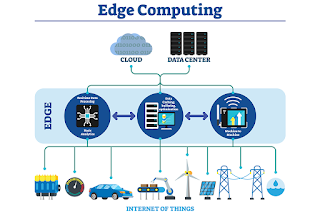Sunday, May 31, 2020
S3 Service
Friday, May 29, 2020
Edge Computing
Edge
computing is a networking philosophy focused on bringing computing as close to
the source of data as possible in order to reduce latency and bandwidth use.
In
simpler terms, edge computing means running fewer processes in the cloud and
moving those processes to local places, such as on a user’s computer, an IoT device,
or an edge server.
Bringing computation to the network’s edge minimizes the amount of
long-distance communication that has to happen between a client and server.
The
increase of IoT devices at the edge of the network is producing a massive
amount of data to be computed at data centers, pushing network bandwidth
requirements to the limit.Despite the improvements of network technology, data
centers cannot guarantee acceptable transfer rates and response times, which
could be a critical requirement for many applications. Furthermore, devices at
the edge constantly consume data coming from the cloud, forcing companies to
build content delivery networks to decentralize data and service provisioning,
leveraging physical proximity to the end user.
In a similar way, the aim of Edge Computing is to move the computation away from data centers towards the edge of the network, exploiting smart objects, mobile phones or network gateways to perform tasks and provide services on behalf of the cloud.
By moving services to the edge, it
is possible to provide content caching, service delivery, storage and IoT
management resulting in better response times and transfer rates
Thursday, May 28, 2020
Docker Volumes
A Docker image is a collection of read-only layers. When you
launch a container from an image, Docker adds a read-write layer to the top of
that stack of read-only layers. Docker calls this the Union File System.
Any time a file is changed, Docker makes a copy of the file from
the read-only layers up into the top read-write layer. This leaves the original
(read-only) file unchanged.
When a container is deleted,
that top read-write layer is lost. This means that any changes made after the
container was launched are now gone.
Mounting a volume is a good solution if you want to:
· Push
data to a container.
· Pull
data from a container.
· Share data between
containers.
A Docker volume "lives" outside the container, on the
host machine.
From the container, the volume acts like a folder which you can
use to store and retrieve data. It is simply a mount point to a directory on
the host.
To create a volume, use the command:
sudo docker volume create
--name [volume name]
List Volumes
To list all Docker volumes on the system, use the command:
sudo docker volume ls
This will return a list of all of the Docker volumes which have
been created on the host.
Inspect a Volume
To inspect a named volume, use the command:
sudo docker volume inspect
[volume name]
To remove a named volume, use the command:
sudo docker volume rm [volume
name]
Monday, May 25, 2020
What is Ansible
- Ansible is free.
- Ansible is very consistent and lightweight, and no constraints regarding the operating system or underlying hardware are present.
- It is very secure due to its agentless capabilities and open SSH security features.
- No need of any special system administrator skills to install and use it.
- Its modularity regarding plugins, inventories, modules, and playbooks make Ansible perfect companion orchestrate large environments.
Sunday, May 24, 2020
Container Orchestration
Chaos Monkey
Saturday, May 23, 2020
Apache Kafka- Docker Installation
Major Challenges in MicroServices
These are the ten major challenges of Microservices architecture and proposed solutions:
-
Azure DevOps is also known as Microsoft visual studio team services (VSTS) is a set of collaborative development tools built for the cloud...
-
It is a tool for developers to develop, release, and operate production-ready containerized applications on Amazon ECS. From getting starte...
-
Confluent Hub is an online repository for extensions and components for Kafka. Kafka is based on extensible model for many of its services. ...


